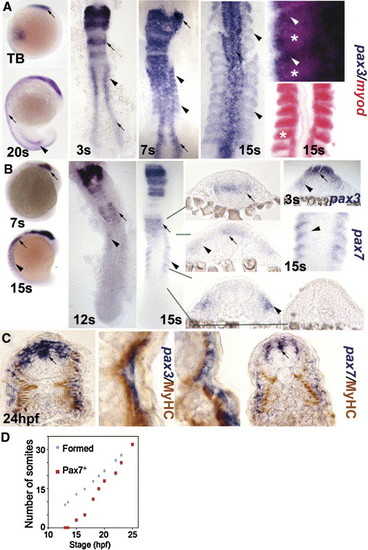Fig. 1
- ID
- ZDB-FIG-070803-1
- Publication
- Hammond et al., 2007 - Signals and myogenic regulatory factors restrict pax3 and pax7 expression to dermomyotome-like tissue in zebrafish
- Other Figures
- All Figure Page
- Back to All Figure Page
|
Pax3 and pax7 expression becomes restricted to the surface of zebrafish somites. In situ mRNA hybridisation for pax3 (A, C left, blue), pax7 (B, C right) and myod (A, red) or immunodetection of slow muscle (C, brown). Whole mounts (A, B) are lateral views, dorsal to left. Flat mounts (A, B) are dorsal view, anterior to top. Transverse cryosections of wholemount-stained embryos (B, C) have dorsal to top. (A, B) Pax3 and pax7 mRNA in neural tissue (arrows) and somites (arrowheads). Wholemount embryos show how pax3 is broadly expressed in new somites, whereas pax7 increases after pax3 mRNA becomes restricted to the anterolateral somite. In high magnification views of somites, note the distinct location of myod in posterior somite (asterisks) and pax3 in anterior (arrowheads). (C) Pax3 and pax7 expression is superficial to slow myosin. Low magnification caudal somite; high magnification rostral somite. (D) Plot of number of somites with pax7 mRNA signal in embryos of each developmental stage. Expression is always in a single series of rostral somites. Note the lag in pax7 expression compared to somite formation. |
| Genes: | |
|---|---|
| Fish: | |
| Anatomical Terms: | |
| Stage Range: | Bud to Prim-5 |
Reprinted from Developmental Biology, 302(2), Hammond, C.L., Hinits, Y., Osborn, D.P., Minchin, J.E., Tettamanti, G., and Hughes, S.M., Signals and myogenic regulatory factors restrict pax3 and pax7 expression to dermomyotome-like tissue in zebrafish, 504-521, Copyright (2007) with permission from Elsevier. Full text @ Dev. Biol.

